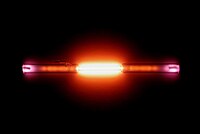
Photo from wikipedia
Abstract Molecular dynamics (MD) methods have been employed to study the point defects production induced by helium (He) plasma exposure and He bubbles interactions in bulk tungsten (W) from the… Click to show full abstract
Abstract Molecular dynamics (MD) methods have been employed to study the point defects production induced by helium (He) plasma exposure and He bubbles interactions in bulk tungsten (W) from the atomic-level perspective. The primary variables examined are: simulation temperature ranging between 300 K and 2300 K, He concentration ranging between 741 appm and 2963 appm in order to study the effects of temperature and He concentration on micro-structural evolution, especially the Frenkel pairs number evolution; for the He bubble, radius up to around 1.25 nm, the He/V ratio up to around 3. In this work, the Frenkel pairs production induced by He aggregation and the volume change of bubble because of the He bubbles interactions are obtained. The results show that the number of Frenkel pairs produced generally increases as the temperature and He concentration increase, but it may reach a saturation with a higher He concentration. It is also found that the equilibrium He/V ratios of He-V bubbles are mainly ranged from 1.6 to 1.9. In addition, we observed that the He atoms in smaller bubble may be trapped into the larger bubble in the cases of their distance below 2 lattice parameters. Due to the decrease in number of He atoms, the He/V ratio of small bubble would decrease. These results can also contribute to the understanding for nucleation and growth of He bubbles in bulk W that are observed by the experiment techniques.
Journal Title: Fusion Engineering and Design
Year Published: 2020
Link to full text (if available)
Share on Social Media: Sign Up to like & get
recommendations!